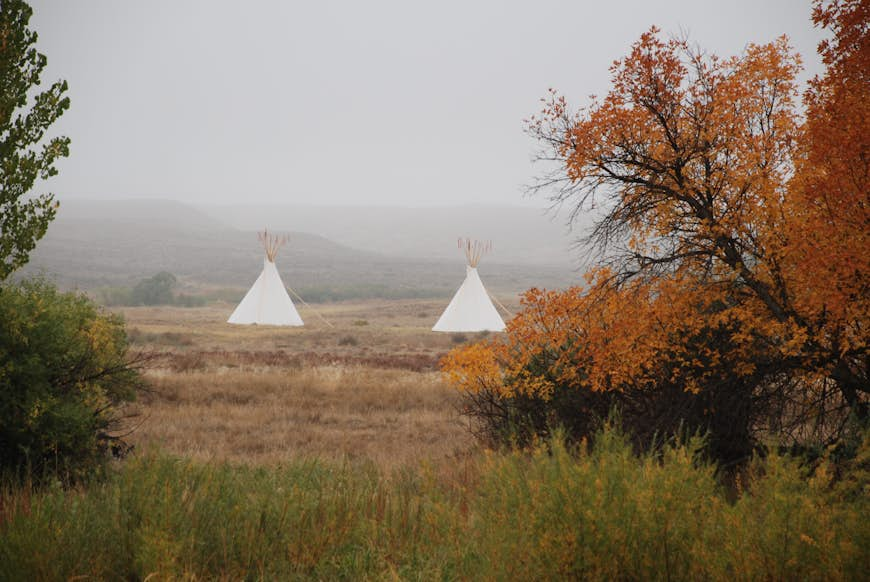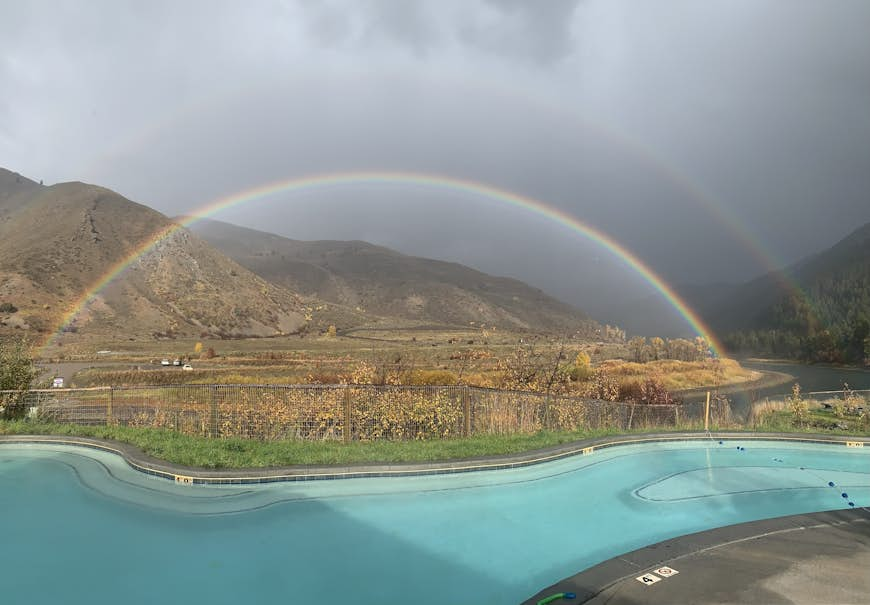At nearly 98,000 square miles, Wyoming has plenty of ground to cover. And although there are a few major interstates that make crisscrossing the state a breeze, some of the best sights and experiences are off the main drags.
Grab a map (you can’t depend on having cell service everywhere you travel), check road conditions on WyoRoad and get ready to explore. Just be prepared – many of these trips take you to some isolated areas. Make sure to always carry a well-stocked emergency kit, good spare tire and full tank of gas.
Here are some road trip ideas to get you out and exploring Wyoming.
Wyoming’s wild west
Best road trip to spot wildlife
Yellowstone National Park-Rock Springs; 400-550 miles; allow 6 days
Next to its geysers and thermal features, Wyoming’s wildlife deserves top billing in the state’s marquee outdoor attractions. Few areas on Earth are as biodiverse as the northwest corner of this fascinating state. Comprising 2.5 million acres of pristine wilderness, Yellowstone and Grand Teton National Parks make up the heart of the world’s largest intact temperate ecosystem. Beyond that, the wider Yellowstone Ecosystem is a dizzying 18 million acres and home to fauna big and small. This tour takes you on a “greatest hits” of the state’s wild spaces.
Start off in Yellowstone National Park, which is home to the region’s “big five:” bears (both grizzly and black), bison, elk, moose and gray wolves. Of particular note is the park’s wolf population, which tops out at around 95 animals now. In the late 19th and early 20th centuries, the animals were almost entirely eradicated from the ecosystem, but they’ve rebounded thanks to preservation efforts. The Hayden, Lamar and Pelican Valleys are prime spots for wildlife viewing.
In neighboring Grand Teton National Park, Oxbow Bend is a favorite spot for spotting moose, pelicans, river otters and other animals.

On the way south to Jackson, make a stop at the National Elk Refuge to view elk (usually seen in winter) as well as wolves, bison and bighorn sheep. Guided sleigh ride tours are a family favorite – hop on a horse-drawn sleigh during the winter months to get an up-close look at elk and other wildlife on the refuge. It can get cold, so be sure to bundle up.
In Dubois, be sure to check out the National Bighorn Sheep Center, where you can learn all about bighorn sheep (the males’ horns can weigh up to 30lbs!) and explore the center’s exhibits, including life-size taxidermy mounts. Print or download a copy of the self-guided tour from the center’s website, or opt for a guided expedition, which is offered seasonally and generally takes 3-4 hours, showcasing the animals’ winter range.
After you’ve become an expert on bighorn sheep, head south to the Pilot Butte Wild Horse Scenic Tour, a self-guided 24-mile route along a gravel road. Here you may be able to spot wild horses and other Wyoming wildlife. High-clearance four-wheel-drive vehicles are recommended on the scenic tour, and there’s no cell service on the frequently empty road. Allow 1.5-2 hours to drive the route, and be aware of variable road conditions.
For the best use of time, we suggest spending three days in Yellowstone, two days in Grand Teton, half a day in Dubois and a few hours on the Pilot Butte Wild Horse Scenic Tour.

Traveling back in time
Best historic road trip
Fort Laramie-Fort Bridger State Historic Site; 434 miles; allow 2-3 days
In the 1800s, Wyoming sat at the confluence of several routes across the Western US. The California and Oregon Trails were the main thoroughfares for emigrants seeking wealth in the mountains and valleys of the West Coast. The Mormon Pioneer Trail traces the route of Brigham Young and his followers after a mob murdered Mormonism’s founding father, Joseph Smith, in Illinois. The region’s earliest mail delivery service followed the Pony Express routes. For many of the half-million who crossed the Wyoming landscape in the 19th century, the region was strange, inhospitable and dangerous.
This route tracks their journey. Start at Fort Laramie National Historic Site, which grew from a mere trading post in 1834 to a major military fort just a few decades later. As westward expansion brought European settlers into contact and conflict with the Northern Plains Indian Nations, the fort became the staging ground for the federal government’s military campaigns against them. Today, the site has a dozen restored buildings and an onsite museum. Make sure to take a peek at the nearby Bedlam Ruts to see remnants of wagon paths.
From there, head to the National Historic Trails Interpretive Center in Casper. The center features interactive exhibits, including virtual stagecoach rides and an enlightening film, as well as a program of stories taken from the journals of the pioneers themselves, narrated by Wilford Brimley.
Be sure to stop at Bessemer Bend National Historic Site, just west of Casper. It was an important river crossing where travelers would ford the river until 1847, when ferries allowed for easier transit across the waterway. Today, most just take the bridge.
Continuing westward, Independence Rock was a landmark where travelers would etch their names and messages into the 1900ft-long rock. Visitors can read these old inscriptions, see wagon ruts and ponder the past.
The last stop is the Fort Bridger State Historic Site, a fork in the road for those continuing southwest to Salt Lake City or northwest on the Oregon Trail. It was a place where travelers along these historic trails would resupply to continue their journey, and it was also used as a station for the Pony Express. More than a dozen historic structures sit on the 37-acre site, such as a replica of a trading post, an officers’ quarters and infantry barracks.

Hot springs road trip
Best road trip for relaxing
Jackson-Saratoga Hot Springs Resort; 448 miles; allow 3-4 days
Yellowstone National Park is known for having the highest concentration of thermal features in the world, so it’s no surprise that the surrounding state is full of hot springs. While you would never want to enter a Yellowstone hot spring – it is illegal and dangerous – there are plenty of hot springs throughout the state where you can enjoy a relaxing soak.
Start at Astoria Hot Springs, about 20 minutes south of Jackson. Astoria Hot Springs’ first manmade pools were constructed in the early 1960s, and community members enjoyed the pools for decades before the park closed in 1998. In recent years, however, the park was revitalized, reopening in late 2020. Relax in any of the five pools along the Snake River. Reservations are recommended.
Next, venture on to Thermopolis to check out Hot Springs State Park, which features a bathhouse with 104-degree water and a “mineral terrace,” where water cascades down the colorful rock. There are also more than six miles of hiking trails nearby. Star Plunge offers even more hot springs fun in Thermopolis, with pools, water slides and a “vapor cave” heated by the hot mineral water – it’s a kind of hot springs waterpark experience.
Stop by Saratoga Hot Springs Resort for a soak in the 70ft-long hot springs pool or one of the smaller, hotter pools topped with teepees. These hot pools are only available to guests or those receiving spa treatments, so make a reservation in advance.

The dino track
Best road trip for fossil lovers
Kemmerer-Greybull; 333 miles; allow 2-3 days
Start this trip back to Jurassic times at Fossil Butte National Monument, located near Kemmerer. Dubbed “America’s Aquarium in Stone,” this fascinating park allows a peek into the past with ranger programs, fossil demonstrations and other educational opportunities. Make sure to explore the visitor center exhibits, which include more than 400 fossil specimens and activities. The fish wall includes 45 fish fossils representing 21 of the 27 species found in Fossil Lake, the 67-mile-long ancient lake that once covered the region.
Next, stop by American Fossil in Kemmerer to try your hand at fossil digging. Whatever you find is yours to keep, so may paleontological fortune be on your side. This area was once inhabited by everything from stingrays and shrimp to crocodiles and the three-toed horse, a smaller ancestor of the modern horse.
Continuing northeast across the state, stop in Thermopolis to check out the Wyoming Dinosaur Center, home to exhibits of skeletons and fossils, and opportunities to delve into paleontology. The center also houses an active preparation lab, where visitors can sign up to learn how to chisel away surrounding material and prepare a specimen. You can also opt for a “dino de-tour,” a tour of a nearby dig site.
In Greybull, the Bighorn Basin Geoscience Center showcases fossils and offers videos and books for visitors to learn more about fossils and dinosaurs. Be sure to check out the 40ft mural depicting what the Wyoming landscape looked like 150 million years ago.
Then head on to the Red Gulch Dinosaur Tracksite, Wyoming’s largest stretch of preserved dinosaur footprints. This 40-acre site includes a boardwalk, trails, picnic tables, interpretive signs and more. The road out is gravel, so be aware of road conditions, and know it may be impassable when muddy or wet. Be prepared for lots of sun and harsh weather, and always keep an eye out for rattlesnakes.
